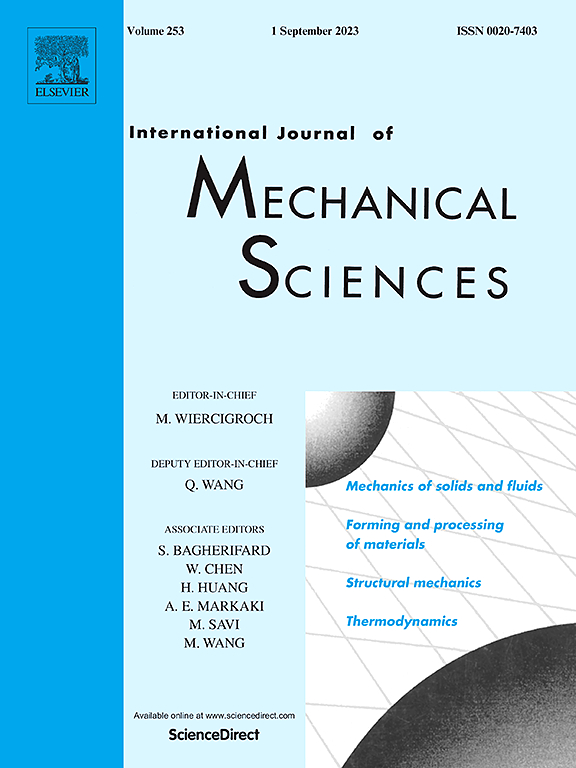Delamination Behavior and Pull-Off Force Analysis of Square Cross-Section Elastomers
IF 7.1
1区 工程技术
Q1 ENGINEERING, MECHANICAL
International Journal of Mechanical Sciences
Pub Date : 2025-03-27
DOI:10.1016/j.ijmecsci.2025.110197
引用次数: 0
Abstract
Achieving high pull-off force in dry adhesive materials often requires a uniform interface stress distribution during delamination. A comprehensive theoretical understanding of delamination behavior, particularly how the interface stress is jointly affected by the interface parameters, material modulus, and width-thickness ratio, is therefore crucial, yet remains lacking. Here, we study the delamination mechanics of square cross-section elastomers, with a focus on their interface stresses and pull-off forces. Two distinct delamination behaviors are exhibited: edge delamination and center delamination. Edge delamination can be further divided into two elastic-stability patterns, rhombus and finger patterns, with transitions driven by the evolution of stress intensity factor distribution along the interface edge. By introducing two key parameters, the ratio of interface stiffness to material modulus ξ and the width-thickness ratio η, and combining FE analysis, we derive quantitative equations for pull-off forces related to edge and center cracks. Our results show that compared to circular cross-section elastomers, square cross-section elastomers are more likely to transition from center delamination to edge delamination as the edge crack pull-off forces decrease due to high stress concentrations at the corners. Square cross-section elastomers exhibit more sensitive pull-off forces within certain ranges of ξ and η, making them a superior option to circular cross-section elastomers for achieving controlled adhesion. This study fills the theoretical gap and provides new guidance for the square cross-section adhesive materials in practical applications.
方形截面弹性体的分层行为和拉拔力分析
要在干粘合材料中获得较高的拉拔力,通常需要在分层过程中获得均匀的界面应力分布。因此,从理论上全面了解分层行为,特别是界面应力如何受到界面参数、材料模量和宽厚比的共同影响至关重要,但目前仍缺乏这方面的研究。在此,我们研究了方形截面弹性体的分层力学,重点关注其界面应力和拉脱力。研究显示了两种截然不同的分层行为:边缘分层和中心分层。边缘分层可进一步分为两种弹性稳定模式:菱形模式和指状模式,其过渡是由沿界面边缘的应力强度因子分布演变驱动的。通过引入两个关键参数,即界面刚度与材料模量之比 ξ 和宽厚比 η,并结合有限元分析,我们得出了与边缘和中心裂纹相关的拉脱力定量方程。我们的结果表明,与圆形截面弹性体相比,方形截面弹性体更容易从中心分层过渡到边缘分层,因为边角处应力集中,边缘裂纹拉脱力会减小。在一定的 ξ 和 η 范围内,方形截面弹性体表现出更敏感的拉脱力,因此在实现受控粘附方面,方形截面弹性体比圆形截面弹性体更胜一筹。这项研究填补了理论空白,为实际应用中的方形截面粘合材料提供了新的指导。
本文章由计算机程序翻译,如有差异,请以英文原文为准。
求助全文
约1分钟内获得全文
求助全文
来源期刊

International Journal of Mechanical Sciences
工程技术-工程:机械
CiteScore
12.80
自引率
17.80%
发文量
769
审稿时长
19 days
期刊介绍:
The International Journal of Mechanical Sciences (IJMS) serves as a global platform for the publication and dissemination of original research that contributes to a deeper scientific understanding of the fundamental disciplines within mechanical, civil, and material engineering.
The primary focus of IJMS is to showcase innovative and ground-breaking work that utilizes analytical and computational modeling techniques, such as Finite Element Method (FEM), Boundary Element Method (BEM), and mesh-free methods, among others. These modeling methods are applied to diverse fields including rigid-body mechanics (e.g., dynamics, vibration, stability), structural mechanics, metal forming, advanced materials (e.g., metals, composites, cellular, smart) behavior and applications, impact mechanics, strain localization, and other nonlinear effects (e.g., large deflections, plasticity, fracture).
Additionally, IJMS covers the realms of fluid mechanics (both external and internal flows), tribology, thermodynamics, and materials processing. These subjects collectively form the core of the journal's content.
In summary, IJMS provides a prestigious platform for researchers to present their original contributions, shedding light on analytical and computational modeling methods in various areas of mechanical engineering, as well as exploring the behavior and application of advanced materials, fluid mechanics, thermodynamics, and materials processing.
 求助内容:
求助内容: 应助结果提醒方式:
应助结果提醒方式:


